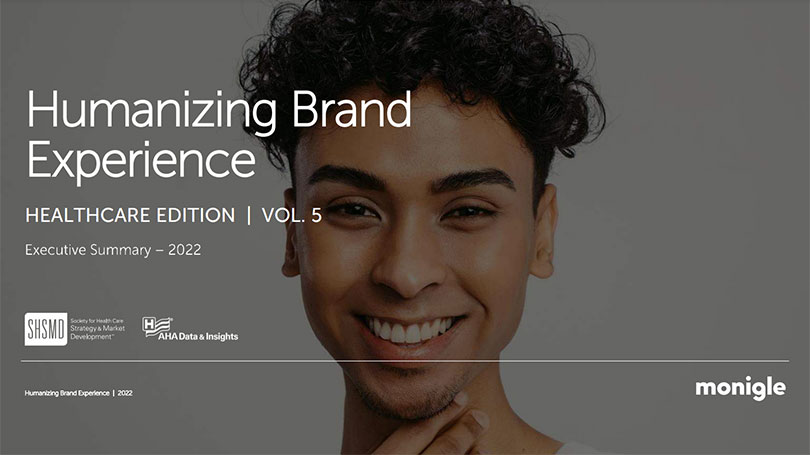
If you didn’t get the chance to view last week’s webinar featuring the latest healthcare insights from Monigle, based upon their online quantitative survey of over 28,000 U.S. respondents, here are my key takeaways from this very worthwhile hour:
- National healthcare engagement remains stagnant and has yet to recover pre-COVID levels. However, the good news is “perceived financial value of healthcare” and “topical interest in watching or reading about health and wellness-related topics” is up. Also, signs of engagement recovery are visible in key metro areas, meaning we can begin to connect with and positively affect people regarding their health.
- Preference for “systemness” is down. With fewer consumers citing “centralized location” and “convenience” as reasons to choose a health system, “bigness is not so big anymore,” shared presenter, Justin Wartell, Monigle Managing Principal. Good news for smaller hospitals. People still like the health system features of wide range of staff and specialists, easier records access, more resources and physicians who communicate more effectively.
- “Self-care” is empowering new behaviors. Fascinating that 1 in 3 people now prefer to try self-care first before seeking in-person care from a provider. And no surprise, they are mostly younger, citing a lack of trust in their healthcare providers to make the right decisions for them. Since 41% research symptoms before making a provider appointment and 31% research symptoms and/or diagnosis after a provider appointment, it’s important to get in on the content game as people turn to on-line resources to manage their health. That pathway should enter the self-care territory to attract these patients of the future.
- The Mental Health Movement is here. With 70% citing the importance of “increasing the availability of mental health services/support”, mental health services should be a high priority for healthcare organizations. Two in five people are still struggling with poor mental health, with LGBTQ+, Hispanic and Asian communities experiencing an inequitable share of this burden with over 50% for each. Since 82% of consumers believe mental health services should be made available for all regardless of ability to pay, health care providers must convey a positive mental health solution and story.
- Holistic care has gone mainstream. A whopping 1 in 3 now prefer holistic or alternative treatments to managing their health over taking medications or prescribed drugs. These include acupuncture, chiropractic care, diet, vitamins, exercise, meditation/yoga, and marijuana/CBD Oil. With 46% citing the importance of “offering more holistic approaches to healthcare outside of traditional medicine”, health care providers should take heed. And note that nomenclature matters, with reference to “whole person health” ranking highest in the consumer mindset.
- Three new consumer segments have emerged. Adding to Monigle’s established four segments of Wellness Influencers, Habitual Strugglers, Trusting Traditionalists and Doctor Dodgers, three new segments were introduced: Unapologetically Unhealthy who leave their health to chance; Positive Preventives who have an optimistic outlook on their health and life; and the fiercely self-reliant Whole-Health Managers, who are masters of their own care. As trendsetters and health seekers, Wellness Influencers remain the most valuable to healthcare brands, however, it is critical to understand what drives each segment to better engage your target audience.
- Healthcare is not inclusive enough. Delayed care is significantly more prevalent among Hispanics (38%) and the LGBTQ+ population (36%). While cost, safety concerns during COVID and insurance issues are factors, lack of time is consistently cited as the key reason for delayed care among non-white consumers. Providers must improve their care provisions per insights from LGBTQ+, Hispanic, Black and Asian consumers including training/education, bilingual services, hiring ethnically diverse staff, and more. Interestingly, University of Michigan Health ranks # 6 in the nation for healthcare brands that are most committed to improving diversity and inclusion.
- 30% use virtual care/telemedicine. With the majority of users in the 35-44 age cohort, virtual care/telemedicine is a key channel for reaching the younger demographic. It can also open doors to the underserved and most challenging “Doctor Dodger” segment. But health care providers must first work on humanizing the virtual care experience to consumer expectations with instant 24/7 access and intuitive UX.
In summary, Wartell shared five key implications for health care professionals: Be the voice of humanity in the boardroom; Prioritize whole-person health offerings and access; Refine your virtual offering; Embrace human diversity and nuance; and most importantly, Be the Changemaker. Professing that we got into this industry because we wanted to help people, he encourages us to lead the way toward equitable healthcare access for all.























